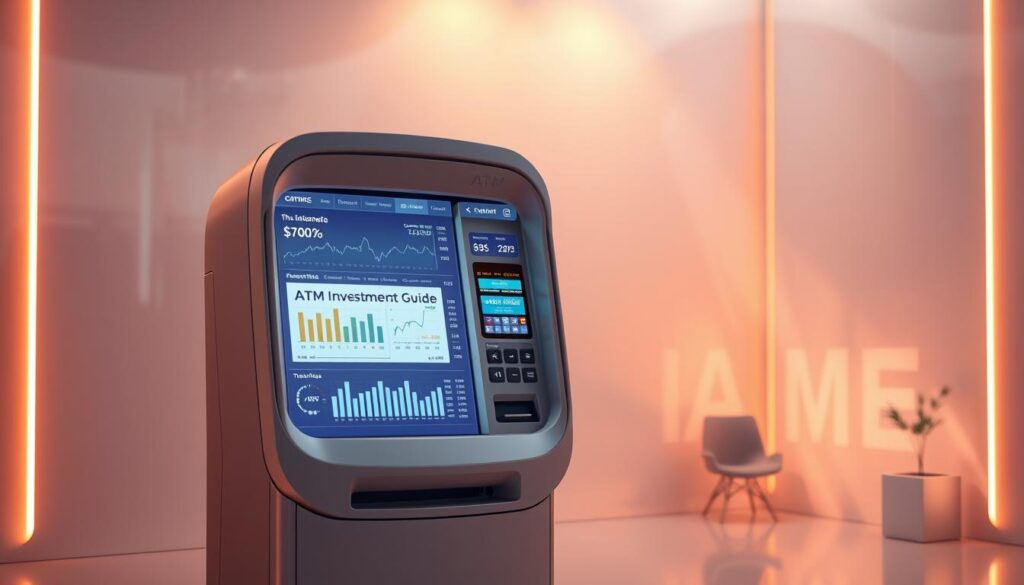Most people see an ATM as just a machine that gives them cash. But what if that same machine could put cash directly into your pocket? For a growing number of savvy investors, these quiet, everyday devices represent a powerful opportunity to generate consistent passive income. This is the world of ATM investments, a business model that turns a familiar piece of technology into a reliable source of cash flow.
This guide will demystify the process of ATM ownership. We’ll explore how these investments work, what makes them profitable, the risks involved, and the strategic steps you need to take to succeed. By the end, you’ll understand how to turn a simple cash dispenser into a valuable asset in your financial portfolio.
What Is an ATM Investment?
An ATM investment involves owning and operating one or more automated teller machines to earn money from the fees charged for transactions. Instead of buying stocks or bonds, you’re investing in a physical asset that provides a tangible service to people every day.
The business model is straightforward. You place an ATM in a high-traffic location, like a convenience store, bar, or event venue. Every time a customer uses your machine to withdraw cash, they pay a small fee. That fee, known as a surcharge, is your primary source of revenue.
There are two main fees that generate income:
- Surcharge Fee: This is the direct fee you charge customers for the convenience of using your machine. You, the owner, set this fee.
- Interchange Fee: This is a small fee paid by the cardholder’s bank to your ATM network for processing the transaction. You receive a portion of this fee as well.
Together, these fees create a steady stream of recurring income from a single machine.
How ATM Investments Generate Revenue
The core of the ATM business is generating revenue from every transaction. Let’s break down how the money flows.
Surcharge Revenue
This is your main profit driver. When a customer withdraws cash, your machine adds a surcharge—for example, $3.00. If your machine processes 200 transactions in a month, that’s $600 in gross surcharge revenue ($3.00 x 200). This is the most visible and significant part of your ATM revenue.
Interchange Fees
Behind the scenes, banks pay small fees to each other to facilitate transactions across different networks. As an ATM owner, you receive a portion of this “interchange” fee from the cardholder’s bank. While it might only be a small amount per transaction (e.g., $0.20 – $0.50), it adds up over hundreds of withdrawals and contributes to your bottom line.
Additional Income Streams
Some ATM owners generate extra revenue through on-screen advertising or by charging fees for balance inquiries. While less common for small operators, these options can provide another layer of income. As explained by ATM Marketplace, the combination of these revenue streams is what drives profitability.
Costs, Risks, and Considerations
Before you start counting profits, it’s crucial to understand the costs and risks involved. A successful ATM business requires careful planning and management.
Initial and Ongoing Costs
- Purchase Cost: A new ATM can cost between $2,000 and $5,000. Used or refurbished machines are cheaper but may require more maintenance.
- Installation: You’ll need to pay for professional installation to ensure the machine is secure and connected properly.
- Vault Cash: You must stock the machine with your own money, known as “vault cash.” This is not an expense—you get it back as customers withdraw it—but it is a significant capital requirement. A machine might need $1,000 to $3,000 in cash to start.
- Maintenance and Repairs: ATMs are machines that can break. You are responsible for repairs, which can range from minor fixes to costly component replacements.
Location and Regulatory Risks
- Location Risk: This is the single biggest factor in your success. A poorly chosen location with low foot traffic will not generate enough transactions to be profitable.
- Regulatory Compliance: You must comply with banking regulations and standards, such as those from the Americans with Disabilities Act (ADA).
- Permits and Licensing: Some states or cities may require you to have a business license or specific permits to operate an ATM.
For a detailed look at the financial side, ATM Depot’s guide on profitability offers excellent insights into how owners make money and what costs to expect.
Case Studies and Real-World Examples
The profitability of an ATM can vary dramatically based on its location.
Example 1: High-Traffic vs. Low-Traffic Locations
According to an analysis from the Casino Gaming Association of America (CGAA), an ATM’s earning potential is all about its placement.
- Low-Traffic Location (e.g., a quiet office building): An ATM might only see 100 transactions a month. At a $3.00 surcharge, that’s $300 in gross revenue. After paying the location owner and other fees, your profit might be minimal.
- High-Traffic Location (e.g., a busy nightclub or a dispensary): An ATM could handle 500 transactions or more per month. At the same $3.00 surcharge, that’s $1,500 in gross revenue, leading to a substantial monthly profit.
Example 2: Common Pitfalls to Avoid
Starting an ATM business is exciting, but many beginners make costly mistakes. As highlighted in a guide from YourMoneyWise, some of the biggest mistakes to avoid include:
- Choosing a Bad Location: Not doing enough research on foot traffic and the need for cash at a potential site.
- Buying a Cheap, Unreliable Machine: Trying to save money up front can lead to higher maintenance costs and more downtime later.
- Neglecting the Host Agreement: Failing to have a clear, written contract with the business owner can lead to disputes down the road.
How to Start Your ATM Investment Journey
Ready to get started? Follow these strategic steps to launch your business correctly.
- Select Your Locations: This is the most important step. Research potential sites by looking for businesses with high foot traffic, businesses that are cash-only, or places where people need cash quickly (like bars, concert venues, or laundromats).
- Calculate Your ROI: Before committing, create a business plan. Project your transaction volume, set a competitive surcharge fee, and subtract all your estimated costs to calculate your potential Return on Investment (ROI).
- Handle Legal and Licensing: Follow a step-by-step guide, like this one from GrowThink, to understand the legal requirements. This includes registering your business and obtaining any necessary permits in your area.
- Negotiate with Business Owners: Approach business owners with a professional proposal. Offer them a small percentage of the surcharge revenue or a flat monthly fee as an incentive to host your machine. Get everything in writing.
Unlock the Power of ATM Investments is about turning a simple machine into a consistent income stream. With smart choices like ideal locations, fee setting, and minimizing running costs, you can build passive revenue while managing risks effectively.
Benefits and Trade-Offs
Like any venture, ATM investing has clear pros and cons.
Benefits
- Predictable Passive Income: Once established, an ATM can provide a very steady and predictable source of cash flow.
- Low Overhead: Compared to other businesses, the ongoing operational costs are relatively low.
- Scalability: You can start with one machine and grow your business at your own pace.
Trade-Offs
- Location Dependency: Your success is almost entirely tied to finding a great location.
- Security Risks: You are dealing with cash and valuable equipment, which carries inherent risks of theft and vandalism.
- Declining Cash Usage: The long-term trend toward a cashless society is a significant consideration, though cash remains essential in many niches. For a balanced view, you can review this list of the pros and cons of an ATM business.
Frequently Asked Questions (FAQ)
1. How much can one ATM make per month?
Profits can range from as little as $100 per month in a slow location to over $1,000 in a high-traffic, cash-heavy environment. The average is often cited as being between $300 and $500 per month.
2. What’s the cost to set up an ATM?
A realistic budget for your first ATM is between $3,000 and $8,000. This covers the machine itself, installation, and the initial vault cash needed to stock it.
3. How do you choose a profitable location?
Look for businesses where people need cash. Prime examples include bars, nightclubs, convenience stores, barbershops, laundromats, and any “cash-only” establishments. High foot traffic is key.
4. What permits or legal issues are involved?
This varies by location, but you will likely need to register as a business. You must also ensure your machine is compliant with network regulations and federal laws like the ADA.
5. Do ATMs still make sense in a cashless world?
While digital payments are growing, cash is far from obsolete. There are many situations and communities where cash is still the preferred method of payment. The key to long-term success is to focus on these cash-heavy niches.
6. How much maintenance does an ATM need?
Modern ATMs are quite reliable. Your main ongoing task is restocking cash. Occasional maintenance might include fixing a card reader jam or updating software, but major repairs are infrequent for new machines.
Conclusion: A Powerful Path to Passive Income
ATM investments offer a unique and tangible way to build a stream of passive income. It’s a business model that is easy to understand, scalable, and not tied to the volatility of the stock market. However, success is not guaranteed. It requires careful planning, a smart location strategy, and a realistic understanding of the costs and risks involved.
If you are willing to do the research and put in the initial effort, unlocking the power of ATM investments can be a highly rewarding financial venture.
Before you invest, model your potential returns with our financial calculators, explore different scenarios with our investment tools, and read our latest financial insights to make an informed decision.

